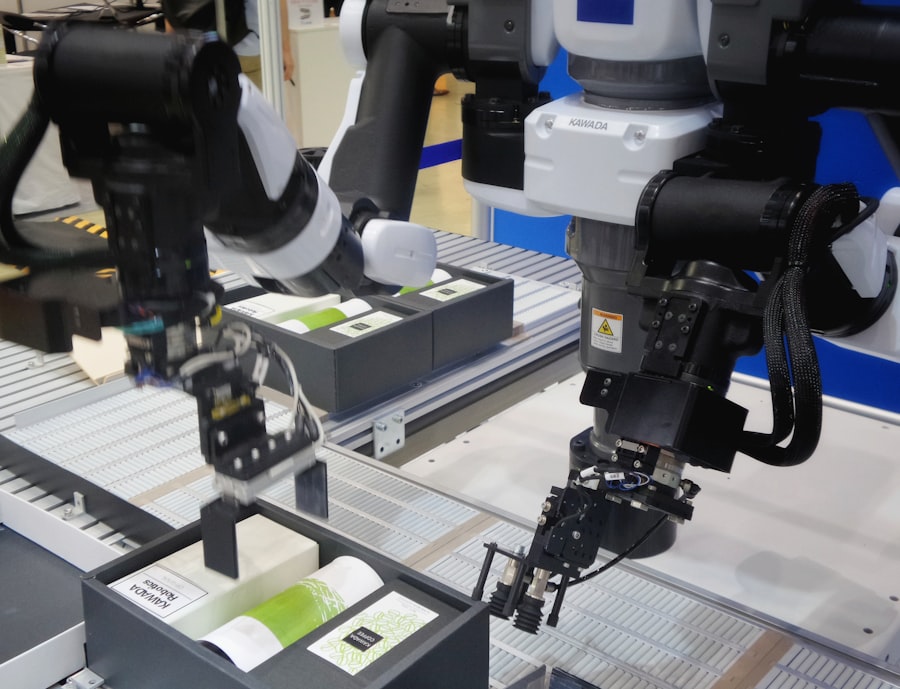The landscape of technology is undergoing a seismic shift, driven by the rapid evolution of artificial intelligence (AI). Emerging AI technologies are not merely a trend; they represent a fundamental transformation in how we interact with machines and process information. From self-learning algorithms to sophisticated neural networks, these innovations are reshaping industries, enhancing productivity, and even redefining the boundaries of creativity.
As we delve into this new era, it becomes increasingly clear that AI is not just a tool but a catalyst for change, influencing everything from healthcare to finance, and even our daily lives. The integration of AI into various sectors is not only enhancing efficiency but also enabling unprecedented levels of personalization and insight. As we stand on the brink of this technological revolution, it is essential to understand the implications of these advancements.
The convergence of AI with other emerging technologies, such as the Internet of Things (IoT) and big data analytics, is creating a synergistic effect that amplifies the capabilities of each individual component. This interconnectedness allows for more sophisticated data analysis and decision-making processes, paving the way for smarter cities, more efficient supply chains, and enhanced customer experiences. However, with these advancements come challenges that must be addressed, including ethical considerations and the potential for job displacement.
As we explore the multifaceted world of AI technologies, it is crucial to maintain a balanced perspective that acknowledges both the opportunities and the challenges that lie ahead.
Key Takeaways
- Emerging AI technologies are revolutionizing various industries and have the potential to significantly impact society.
- Machine learning and deep learning advancements are driving the development of AI technologies, enabling more sophisticated and intelligent systems.
- Natural language processing plays a crucial role in AI, allowing machines to understand and interpret human language.
- AI has the potential to transform robotics and automation, leading to increased efficiency and productivity in various sectors.
- Ethical considerations are essential in the development of AI technologies to ensure responsible and beneficial use for society.
The Impact of AI on Various Industries
Revolutionizing Healthcare with AI
In the healthcare sector, AI technologies are revolutionizing diagnostics and patient care. Machine learning algorithms can analyze vast amounts of medical data to identify patterns that may elude even the most experienced professionals. This capability not only enhances diagnostic accuracy but also enables personalized treatment plans tailored to individual patients’ needs. Furthermore, AI-driven tools are streamlining administrative tasks, allowing healthcare providers to focus more on patient interaction rather than paperwork. The result is a more efficient healthcare system that promises improved outcomes and reduced costs.
Transforming the Finance Industry with AI
In the realm of finance, AI is reshaping how institutions manage risk and make investment decisions. Algorithms capable of processing real-time data can predict market trends with remarkable accuracy, allowing traders to make informed decisions at lightning speed. Additionally, AI-powered chatbots are transforming customer service by providing instant responses to inquiries and facilitating transactions without human intervention.
The Far-Reaching Impact of AI
This shift not only enhances customer satisfaction but also reduces operational costs for financial institutions. As AI continues to permeate various sectors, it is clear that its impact is profound and far-reaching, fundamentally altering how businesses operate and interact with their customers.
Advancements in Machine Learning and Deep Learning

At the heart of many emerging AI technologies lies machine learning (ML) and its more advanced counterpart, deep learning (DL). These methodologies enable systems to learn from data and improve their performance over time without explicit programming. Machine learning algorithms can identify patterns in data sets, making them invaluable for applications ranging from predictive analytics to image recognition.
Deep learning takes this a step further by utilizing neural networks with multiple layers to process complex data inputs, such as images or natural language. This capability has led to breakthroughs in fields like computer vision and speech recognition, where traditional algorithms struggled to achieve comparable results. The advancements in ML and DL are not just technical feats; they are also driving innovation across various sectors.
For example, in the automotive industry, deep learning algorithms are integral to the development of autonomous vehicles. These systems rely on vast amounts of data collected from sensors and cameras to navigate complex environments safely. Similarly, in entertainment, machine learning is being used to analyze viewer preferences and recommend content tailored to individual tastes.
As these technologies continue to evolve, they promise to unlock new possibilities that were once thought to be the realm of science fiction, pushing the boundaries of what machines can achieve.
The Role of Natural Language Processing in AI
| Metrics | Description |
|---|---|
| Accuracy | The percentage of correctly processed natural language inputs by the NLP system. |
| Speed | The time taken by the NLP system to process and generate outputs for natural language inputs. |
| Robustness | The ability of the NLP system to handle variations and complexities in natural language inputs. |
| Scalability | The capability of the NLP system to handle increasing volumes of natural language data and requests. |
| Interpretability | The ease of understanding and interpreting the outputs generated by the NLP system. |
Natural Language Processing (NLP) is a critical component of AI that focuses on enabling machines to understand and interpret human language. This field has seen remarkable advancements in recent years, driven by improvements in machine learning techniques and the availability of large datasets. NLP applications range from simple text analysis to complex conversational agents capable of engaging in meaningful dialogue with users.
The ability for machines to comprehend context, sentiment, and nuance in language has opened up new avenues for human-computer interaction, making technology more accessible and intuitive. Moreover, NLP is transforming industries such as customer service, marketing, and content creation. Businesses are leveraging NLP tools to analyze customer feedback and sentiment on social media platforms, allowing them to tailor their strategies accordingly.
In content creation, AI-driven writing assistants are helping authors generate ideas and refine their work by providing suggestions based on linguistic patterns. As NLP continues to advance, it holds the potential to bridge communication gaps between humans and machines, fostering a more seamless integration of technology into our daily lives.
Exploring the Potential of AI in Robotics and Automation
The intersection of AI with robotics and automation is one of the most exciting frontiers in technology today. Robots equipped with AI capabilities can perform tasks that require not only precision but also adaptability in dynamic environments. From manufacturing floors where robots assemble products with incredible accuracy to service robots that assist in hospitality settings, the potential applications are vast.
These intelligent machines can learn from their experiences, improving their performance over time and reducing the need for human intervention in repetitive or hazardous tasks. Furthermore, the integration of AI into robotics is paving the way for innovations that enhance productivity across various sectors. In agriculture, for instance, AI-powered drones are being used for crop monitoring and precision farming, optimizing resource use while minimizing environmental impact.
In healthcare, robotic surgical systems equipped with AI can assist surgeons by providing real-time data analysis during procedures. As we continue to explore the potential of AI in robotics and automation, it becomes evident that these technologies will play a crucial role in shaping the future workforce and redefining what it means to work alongside machines.
Ethical Considerations in the Development of AI Technologies

Addressing the Ethical Concerns of AI Development
As we harness the transformative power of AI technologies, it is crucial to address the ethical considerations that accompany their development and deployment. One significant concern revolves around bias in AI algorithms, which can perpetuate existing inequalities if not carefully managed. For instance, if training data reflects societal biases—whether related to race, gender, or socioeconomic status—AI systems may inadvertently reinforce these biases in their decision-making processes.
Ensuring Accountability and Transparency in AI
This raises critical questions about accountability and transparency in AI development, necessitating rigorous standards for data collection and algorithm design. Moreover, the implications of AI on employment cannot be overlooked. While automation promises increased efficiency and productivity, it also poses a threat to traditional job roles across various industries.
Navigating the Impact of AI on Employment
As machines take over repetitive tasks, there is a growing concern about job displacement and the need for reskilling workers to adapt to new roles that require human creativity and emotional intelligence. Balancing technological advancement with social responsibility will be essential as we navigate this complex landscape.
Shaping an Equitable Future with AI
Engaging stakeholders from diverse backgrounds—including ethicists, technologists, policymakers, and community representatives—will be crucial in shaping an equitable future where AI benefits all members of society.
The Future of AI and Its Implications for Society
Looking ahead, the future of AI holds immense promise but also presents significant challenges that society must confront. As AI technologies continue to evolve at an unprecedented pace, their integration into everyday life will become increasingly seamless. From smart homes equipped with intelligent assistants to personalized healthcare solutions driven by predictive analytics, the potential applications are boundless.
However, this rapid advancement necessitates a proactive approach to governance and regulation to ensure that these technologies are developed responsibly and ethically. The implications of AI for society extend beyond mere convenience; they touch upon fundamental questions about privacy, security, and human agency. As machines become more autonomous and capable of making decisions on behalf of individuals or organizations, concerns about surveillance and data privacy will intensify.
Striking a balance between innovation and safeguarding individual rights will be paramount as we navigate this new terrain. Ultimately, fostering an inclusive dialogue among technologists, policymakers, ethicists, and the public will be essential in shaping a future where AI serves as a force for good—enhancing human potential while respecting our shared values and rights as individuals within a diverse society.
In the rapidly evolving world of technology, staying updated with the latest advancements is crucial. One such advancement is the integration of AI in digital marketing strategies. If you’re interested in understanding how AI can transform digital marketing efforts, enhance user engagement, and drive business growth, I recommend reading an insightful article on this topic. You can find it at Marmlax’s Digital Marketing Strategies. This article explores various AI tools and techniques that are reshaping the landscape of digital marketing, providing a comprehensive overview that is beneficial for marketers and business owners alike.
FAQs
What are emerging AI technologies?
Emerging AI technologies refer to the latest advancements and developments in the field of artificial intelligence. These technologies include machine learning, natural language processing, computer vision, and robotics, among others.
What are some examples of emerging AI technologies?
Some examples of emerging AI technologies include deep learning, reinforcement learning, generative adversarial networks (GANs), autonomous vehicles, and AI-powered healthcare diagnostics.
How are emerging AI technologies being used in various industries?
Emerging AI technologies are being used in various industries such as healthcare, finance, manufacturing, retail, and transportation. They are being used for tasks such as predictive analytics, personalized recommendations, autonomous vehicles, and medical diagnostics.
What are the potential benefits of emerging AI technologies?
The potential benefits of emerging AI technologies include increased efficiency, improved decision-making, enhanced customer experiences, and the ability to automate repetitive tasks. These technologies also have the potential to drive innovation and create new business opportunities.
What are some potential challenges and risks associated with emerging AI technologies?
Some potential challenges and risks associated with emerging AI technologies include ethical concerns, job displacement, data privacy issues, and the potential for bias in AI algorithms. There are also concerns about the potential misuse of AI technologies for malicious purposes.






